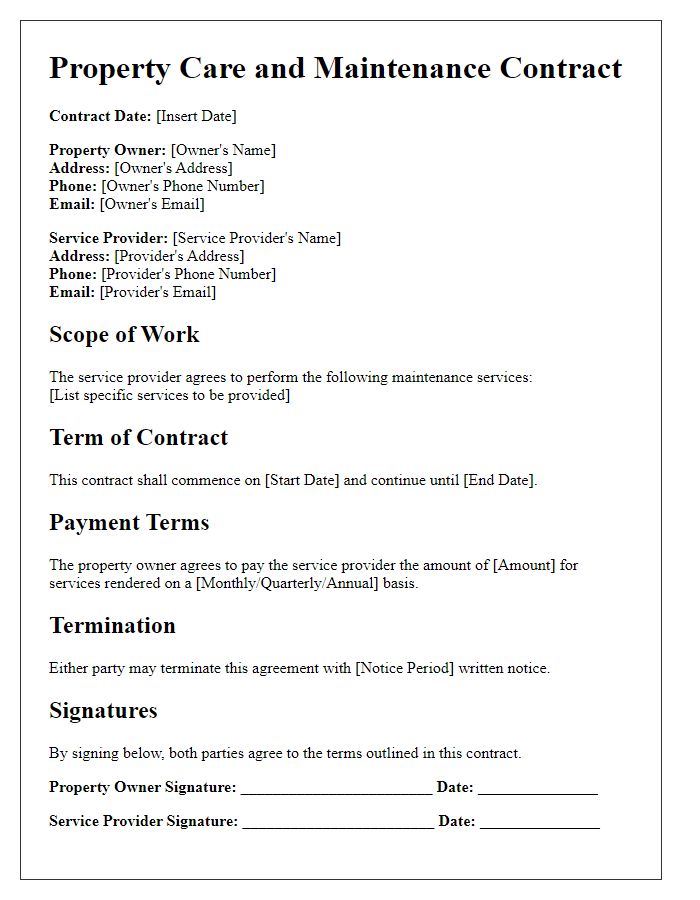Are you a property owner in need of a reliable maintenance solution? A well-crafted property maintenance agreement can be your best friend in ensuring that your property stays in top shape while protecting your investment. It outlines the responsibilities of both parties, helping to create a seamless relationship between you and your maintenance provider. Curious to learn how to tailor this agreement for your specific needs? Read on!

Parties Involved
Property maintenance agreements typically involve several key parties. The property owner, often referred to as the "Landlord" or "Property Manager," is responsible for the overall management of the property, including maintenance and repairs. The contractor or maintenance provider, commonly known as the "Service Provider," is hired to perform specific maintenance tasks, which can include plumbing, electrical work, landscaping, or general repairs. Additionally, tenants residing in the property play a crucial role as they directly experience the impact of maintenance services on their living conditions. Clear communication and defined responsibilities among these parties are essential for effective property management and maintenance.
Scope of Services
The scope of services in a property maintenance agreement encompasses essential tasks required for the upkeep of residential or commercial properties, ensuring they remain in optimal condition. Routine inspections of key areas such as roofs, plumbing systems, and HVAC (heating, ventilation, and air conditioning) units are imperative, typically occurring quarterly or bi-annually to preemptively identify maintenance issues. Landscaping services may include lawn care, tree trimming, and flower bed management, executed seasonally to enhance curb appeal and property value. Cleaning services, ranging from routine janitorial work to specialized deep cleaning, support hygiene and aesthetic standards in high-traffic areas. Emergency repair services cover unforeseen incidents such as plumbing leaks or electrical failures, providing a response time often stipulated within 24 hours to minimize property damage. Regular communication and detailed reporting of service activities through documented logs keep property owners informed about the overall state of their premises, fostering transparency and trust.
Term and Termination
The property maintenance agreement specifies the duration of service, commencing from the date of signing. The standard term is 12 months, with an option to renew, subject to performance review. Either party may terminate the agreement with written notice of 30 days prior to the desired termination date. In cases of breach, immediate termination may occur without notice. This clause ensures clarity regarding the expectations and responsibilities of both parties throughout the agreement period, safeguarding the interests of property owners and maintenance providers alike.
Payment and Fees
In a property maintenance agreement, fees and payment structures are essential for maintaining transparency and accountability. Typically, property owners, such as landlords in urban areas or residential managers, pay a monthly service charge, which can range from $100 to $1,000 depending on the scope of services provided. This may include routine inspections, landscaping, plumbing, and emergency repairs. Additionally, some agreements stipulate a one-time setup fee for new clients, which could be between $200 and $500. Payment terms often specify due dates, typically within the first week of each month, and may include penalties for late payments, such as a 5% fee on overdue amounts. Clear delineation of responsibilities regarding maintenance tasks ensures that property value remains protected, particularly for properties located in rental markets such as New York or Los Angeles, where competition is high. Regular invoices itemizing services provided can enhance tracking and accountability, fostering a better relationship between property owners and maintenance providers.
Liability and Insurance
In property maintenance agreements, liability and insurance clauses play a crucial role in defining responsibility for damages and ensuring adequate protection for both property owners and service providers. Insurance policies, such as general liability coverage, often stipulate specific limits, like $1 million per occurrence, safeguarding against property damage or personal injury claims. The agreement should outline the maintenance provider's responsibilities to maintain continuous coverage, including workers' compensation insurance for employees, which complies with state regulations. It's essential to include provisions mandating timely communication of any lapses in coverage, as well as the requirement for the service provider to name the property owner as an additional insured party, ensuring their protection in case of litigation arising from maintenance activities. Proper documentation of insurance certificates is also vital, ensuring compliance and clarity for both parties involved.
















Comments